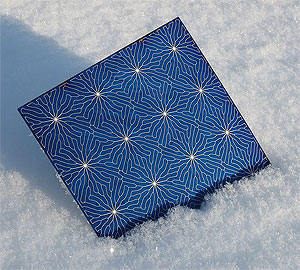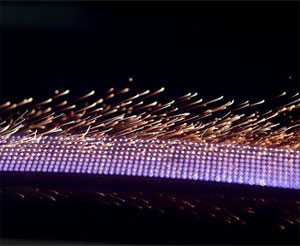AACHEN, Germany, March 9, 2009 – The total installed solar energy output in Germany will increase tenfold by the year 2017, according to the European Photovoltaic Industry Association (EPIA). However, to do so, the cost of manufacturing solar cells must be reduced and the cells must be made more efficiently.
In hopes of reaching these goals, 10 companies and institutes are collaborating on a $7.5 million EU project called the Next Generation Solar Cell and Module Laser Processing Systems (SOLASYS). Funded by the Fraunhofer Institute for Laser Technology, this project will demonstrate the feasibility of an efficient laser manufacturing process in making solar cells.

Front side of a “Sunweb” MWT solar cell made by Solland Solar, a SOLASYS partner. The front side contact is transferred to the rear side at the point where the lines meet. ( Image: Solland Solar Cells)
The SOLASYS project will use a laser-based materials processing tool, which has many advantages, such as noncontact machining, controlled energy input, high speed and precision. The 36-month project launched Sept. 1, 2008.
Five specific processes are involved: high-speed drilling of microscopically small holes, ablation of thin layers without damage to the substrate, laser soldering for cell interconnection, laser isolation of the front and rear sides as well as laser-based selective doping.
Laser drilling is just one example of how SOLASYS will lower costs for the manufacturing of silicon solar cells. The metal wrap through (MWT) concept involves transferring the metal contacts from the front of the cell to the back using drilled holes with the diameter of a human hair. This requires drilling 100 holes in less than a second. The aim of this method is to increase cell efficiency by reducing shading from contacts on the front side of the panel, and to simplify cell contacting, since both electrical terminals are on the rear side. 
High-speed drilling of silicon wafers produces over 10,000 drill holes per second. (Image: Fraunhofer Institute for Laser Technology)
In the future, the connection of several cells to form a single module will also be performed using lasers. Laser soldering permits precise control of the soldering temperatures and hence specific process optimization. If the temperature at the solar cell deviates from the set value, the laser output can be adjusted accordingly, which enables a high-quality solder joint and low thermal stress.
According to SOLASYS, a throughput of one cell per second will be attained even for modern, complex cell concepts thanks to this project. Production lines will be set up to demonstrate the industrial feasibility of this laser machining approach.
The SOLASYS project includes, developers of laser systems, Trumpf Laser and Laserline, both of Germany; German-based machine manufacturer, Manz Automation; research institutes CNRS-LP3 from France and IMEC from Belgium; solar cell manufacturers, BP Solar from Spain, Solland Solar from The Netherlands, and Energy Solutions form Bulgaria; manufacturer of beam guiding systems, Scanlab AG from Germany; and head of the project, the Fraunhofer Institute for Laser Technology in Germany.
The project's initial results will be presented at the coming international trade fair LASER 2009 - World of Photonics, which will be held in Munich from June 15-18, 2009.
For more information, visit: www.solasys.eu